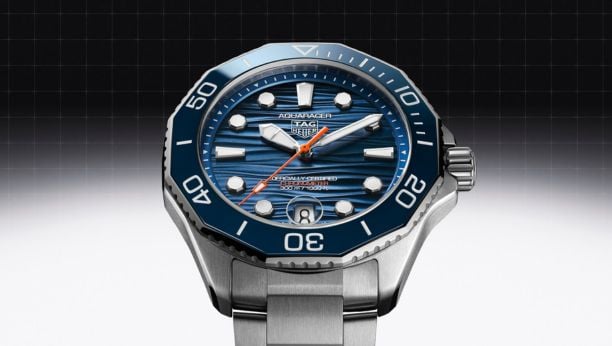VINTAGE COLLECTION
TAG HEUER FORMULA 1
At the launch in 1986, TAG Heuer’s Formula 1 collection had everything going for it. Colorful, inexpensive quartz watches that were made in Switzerland were taking the world by storm; under the new ownership by TAG, the company had abundant resources to develop this collection of watches and chronographs; and the “Formula 1” name itself drew on the company’s deep, historic connection to motorsports.
Over the intervening years, the Formula 1 collection has remained a vibrant and popular part of the TAG Heuer catalogue, as the company has offered a rich variety of colours, materials, styles and movements.
From the simple fiberglass watches in 1986 to the most recent chronographs powered by TAG Heuer’s state-of-the-art automatic movements, the Formula 1 watches and chronographs have captured the spirit and energy of motorsports, in a unique and unrivalled manner.
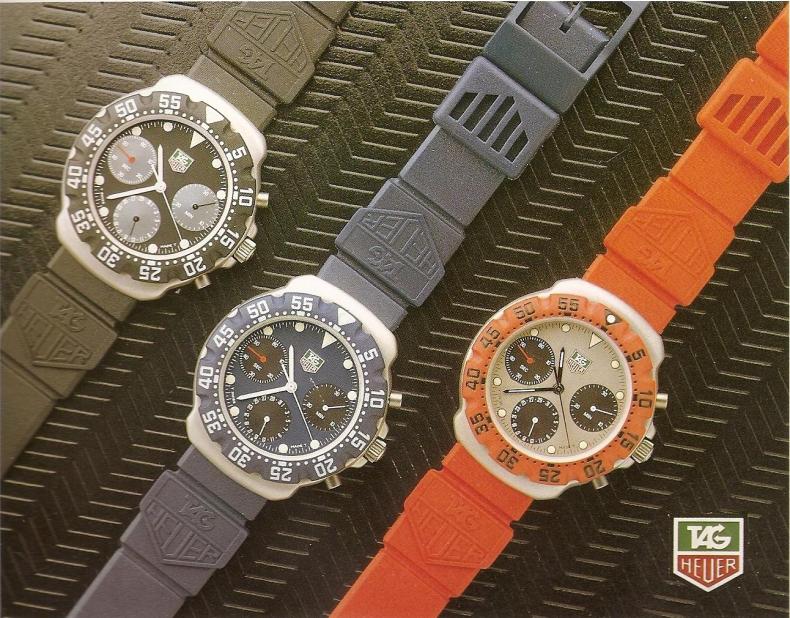
1986 marked a pivotal moment for TAG Heuer, as a company and as a watch brand. Having introduced its first dive watches in 1978, over the next eight years TAG Heuer had followed up on its initial success with the introduction of three collections – the 1000 Series, the 2000 Series and the 3000 Series. The Executive collection would come in 1984, marking Heuer’s move into a new category – elegant, premium quality watches that drew their inspiration from dive watches.
While TAG Heuer was having great success with its collections of dive watches, an entirely new category of watches was revolutionizing the Swiss watch industry. As low-priced quartz watches from Japan flooded global markets, in Fall 1983, an independent Swiss watch brand (Swatch), began selling colorful plastic watches, with quartz movements and traditional analog hands, at a price of 50 CHF. These stylish but inexpensive watches took the world by storm, at the same time providing a significant boost to the Swiss watch industry.
When Techniques d’Avant Garde completed its acquisition of Heuer in January 1986, TAG Heuer was positioned to launch an entirely new type of watch. Not a racing chronograph, and not a dive watch, the new Formula 1 collection would capitalize on the demand for colorful, inexpensive quartz watches. The “Formula 1” name was perfect for TAG Heuer’s new collection, with Jack Heuer having developed Formula 1 sponsorships in the 1960s and 70s, and TAG Heuer having what would be a long-lived partnership with McLaren in 1985. TAG Heuer catalogues of the period proclaimed proudly that the “Formula 1” name was in honor of the company’s highly successful involvement with the Marlboro McLaren Formula 1 racing team.
The choice of the “Formula 1” name for the new collection was also symbolic of the new TAG Heuer, as perhaps the only thing that TAG and Heuer had it common in 1986 was their deep connection to Formula 1 racing. Heuer had of course been a sponsor of Ferrari during the 1970s, while TAG was the principal sponsor of the Williams team from 1979-1981, before buying 50% of McLaren International at the end of the 1981 season. TAG then funded the development of the Porsche 1.5 litre turbo engine that would power the McLaren-TAG cars to consecutive World Championships in 1984 and 1985. TAG remained a sponsor as the Marlboro McLaren transitioned to Honda power, later in the 1980s.
And so the early TAG Heuer catalogues from late 1980s would be dominated by dive watches and the new Formula 1 collection, with the classic chronographs from the 1960s and 70s having run their course.
Despite the immense success of the Formula 1 collection, with sales of over 3,000,000 watches, the watch had only a short life – at least initially – being discontinued in 2000. Brought back a few years later, the Formula 1 remains a key part of the TAG Heuer range, focused on the value-end of the market, with designs that capture the excitement of the ultimate form of motorsports.
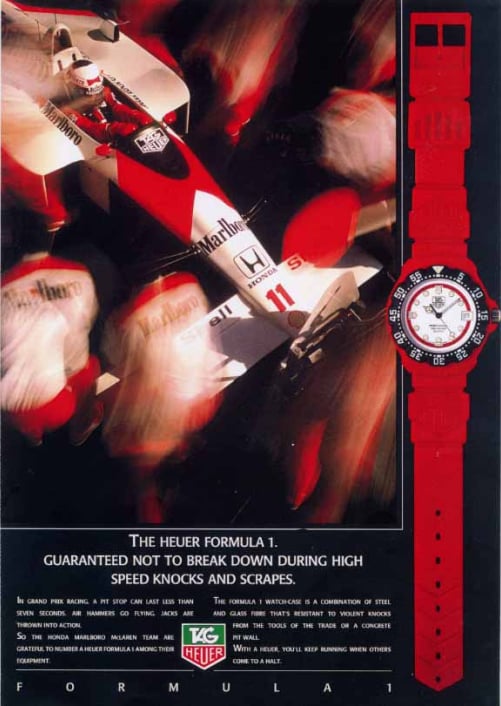
FORMULA ONE SERIES 1: 1986 - 1990
The first-generation Formula 1 watches were designed by Eddy Burgener and used an innovative case construction - a mixture of a stainless steel inner case coated with fiberglass. Interestingly, Heuer had used fiberglass for the cases of two of its economy collections in the early 1970s, the Temporada and the East Rider.
The initial range of Formula 1 watches was limited to two sizes (28mm and 34mm) of brightly coloured cases matched to plastic straps that you could cut to size. Among the choices in the early years of the Formula 1 collection (1986 through 1990) were fiberglass cases in black, white, red, blue and pink, with bright bezels expanding the palette to include green and yellow. Dial colours covered a similar range of colours, along with choices with luminous dials, evoking the company’s tradition in dive watches.
The design was unlike any other contemporary Heuer or TAG Heuer watch, with the only familiar design traits being the Mercedes-style hands already used on many of the brand’s dive watches.
In 1987 the range expanded to include a stainless steel case and bracelet as well as a range of new colours. The fiberglass models continued to be sold until 1993/4 and stand out today as the real signature watch of the Formula 1 collection.
The first series Formula 1 watches use a variety of quartz movements. Early watches use either a Harley Ronda SA 705 movement or an ESA 965.312 module, while the majority of the later watches use the ETA 955.412/ 955.414 movement.
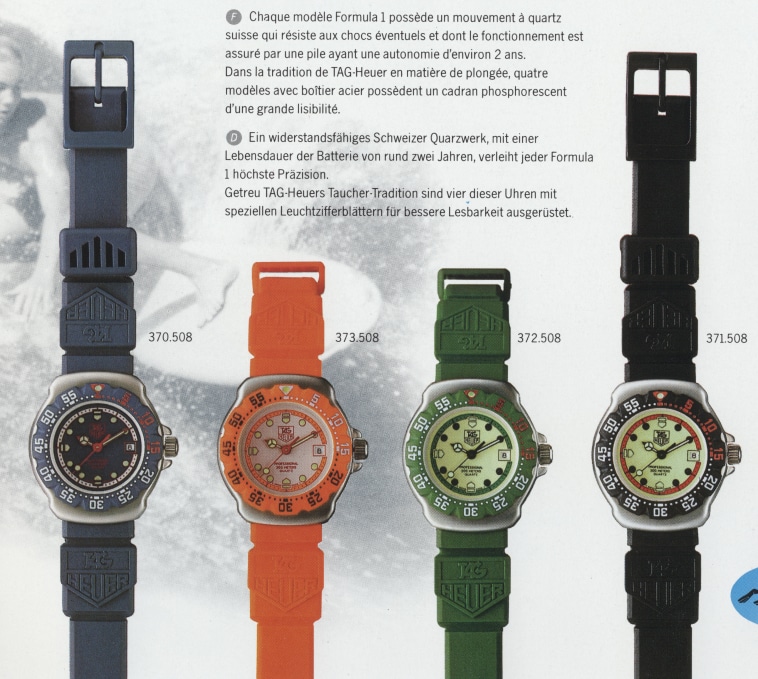
FIRST GENERATION FORMULA ONE CHRONOGRAPH
In keeping with the sporting theme of the Formula 1 collection, TAG Heuer added a chronograph to the collection in 1989.
The Formula 1 chronograph was powered by a complex mechanical-quartz movement, which was made by Ronda. The module had an unusual analogue date display on the 6 o’clock register, elapsed minutes at 3 o’clock and chronograph seconds at 9 o’clock. Consistent with the colorful style that defined the Formula 1 collection, dials choices were black, blue and gray, with a bright red bezel and strap on the model with the gray dial. Models with black and blue dials used matching straps and bezel.
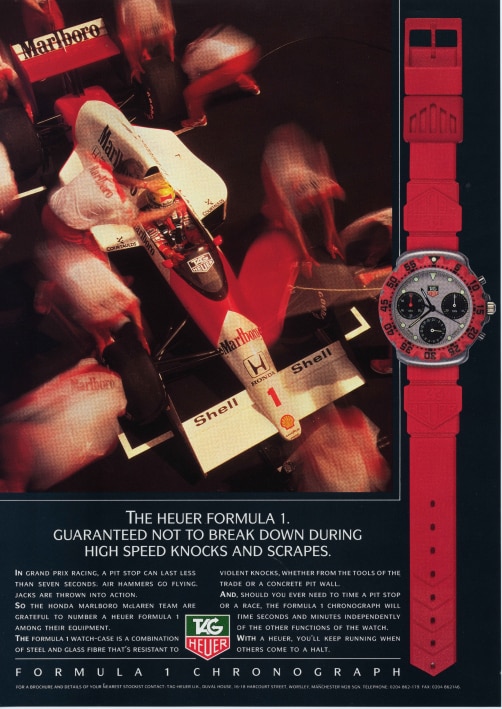
SECOND GENERATION FORMULA ONE CHRONOGRAPH
In 1991, TAG Heuer introduced an updated version of the Formula 1 chronograph. Following a more traditional approach and layout, the date was deleted, with the three registers indicating hours, minutes and 1/10 seconds, with the chronograph seconds indicated by the hand mounted on the center pinion.
From 1991 to 1995 the dial on this version of the chronograph had “1/10th” under the TAG Heuer logo and “Chronograph” at 9 o’clock.
FORMULA ONE SERIES 2: 1997 - 2000
Having gone more than 12 years unchanged, TAG Heuer launched a new Formula 1 series in 1998, dropping the basic watch and upgrading the chronograph model. The Series 2 chronograph uses the same case design as the original, but with a distinctly different dial: large Arabic numerals for the hours and a smaller minute scale on its outer-edge, with a patterned inner circle. The Series 2 model used triangular hands for both the time-of-day and chronograph hands. The Series 2 Formula 1 continued using the ETA 251.262 movement, and introduced a Rubber-strap option.
DISCONTINUING THE FORMULA 1
LVMH acquired TAG Heuer in 1999, and despite the success of the Formula 1 collection, it was dropped from the TAG Heuer catalog in 2000. While sales of the Formula 1 had always been strong, the low cost and casual style of the collection didn’t fit with the plans of LVMH to take the brand up-market.
While the low-cost ethos of the Formula 1 collection made sense in 1985, the market had changed so that a watch using mineral glass and a plastic bezel was simply seen as too compromised in 2000, especially for a brand that was part of a luxury group. The Heuer and TAG Heuer collections had always evolved from one decade to the next, so while the Formula 1 range may have been perfect for the brand in the mid-1980s (after the acquisition of Heuer by TAG), the style and construction was not consistent with the strategy that LVMH brought to the TAG Heuer brand.
FORMULA ONE SERIES 3: 2004 -2007
After a break of four years, TAG Heuer brought back the Formula 1 collection in 2004 with an entirely new design and upgraded materials.
The Series 3 of the Formula 1 collection featured a titanium-carbide coated steel bezel, a case made of grade 316L stainless steel, and a sapphire crystal. The dial introduced a totally new look for the Formula 1, with metal-look hour-markers and numerals at 12, 3, 6 and 9 o’clock. The hands were also restyled, though they maintained their basic triangular geometry.
The basic shape of the case and bezel for the series 3 Formula 1 remained as it was, echoing the original models. The Series 3 Formula 1 used a 40 mm case, compared with the 34 mm of the predecessor, bringing the watch into line with contemporary tastes. One trademark of the series 3 Formula 1 collection was the use of polyurethane “bumpers” on either side of the case, which gave the models a distinctive look.
The overall look of the series 3 Formula 1 watch was a chunky, trendy design, which fitted with its positioning as the youthful, less formal watch in the TAG Heuer catalogue. In advertising for the Formula 1, TAG Heuer used the slogan “Chill Out”, confirming the position of the collection as a casual watch.
TAG Heuer also introduced new movements for the series 3 Formula 1 models. The Formula 1 watch was powered by the ETA F06.111, while the chronograph version (with the distinctive tri-color 6 o’clock register) was powered by the ETA G10.711.
Note that all the Formula 1 watches from 2004 to today have the words “ TAG Heuer Formula 1 ” on the dial, rather than just the model name “ Formula 1 “ as on other TAG Heuer watches.
FORMULA ONE SERIES 4: 2007 - 2011
The fourth series of the Formula 1 collection was an evolution of the 2003 re-design. The distinctive polyurethane bumpers on the sides of the case were replaced by “ TAG Heuer ” branding.
The new series 4 version of the Formula 1 was 1 mm larger than the previous model -- 41 mm for both the watch and the chronograph -- and once again used improved materials, most notably the finishing on the bezel which now used raised fine-brushed numbers (compared with the previous engraved and painted numbers).
The distinguishing design detail of the new version of the Formula 1 chronograph was the over-sized register at 6 o’clock, with this register also framed by a silver ring. The Formula 1 watch used markers for all hours and added 5-minute numerals to the minute scale on the outer-edge of the dial.
Both the chronograph and the three-hand watch continued with same movements -- ETA G10.711 movement and ETA F06.111 respectively.
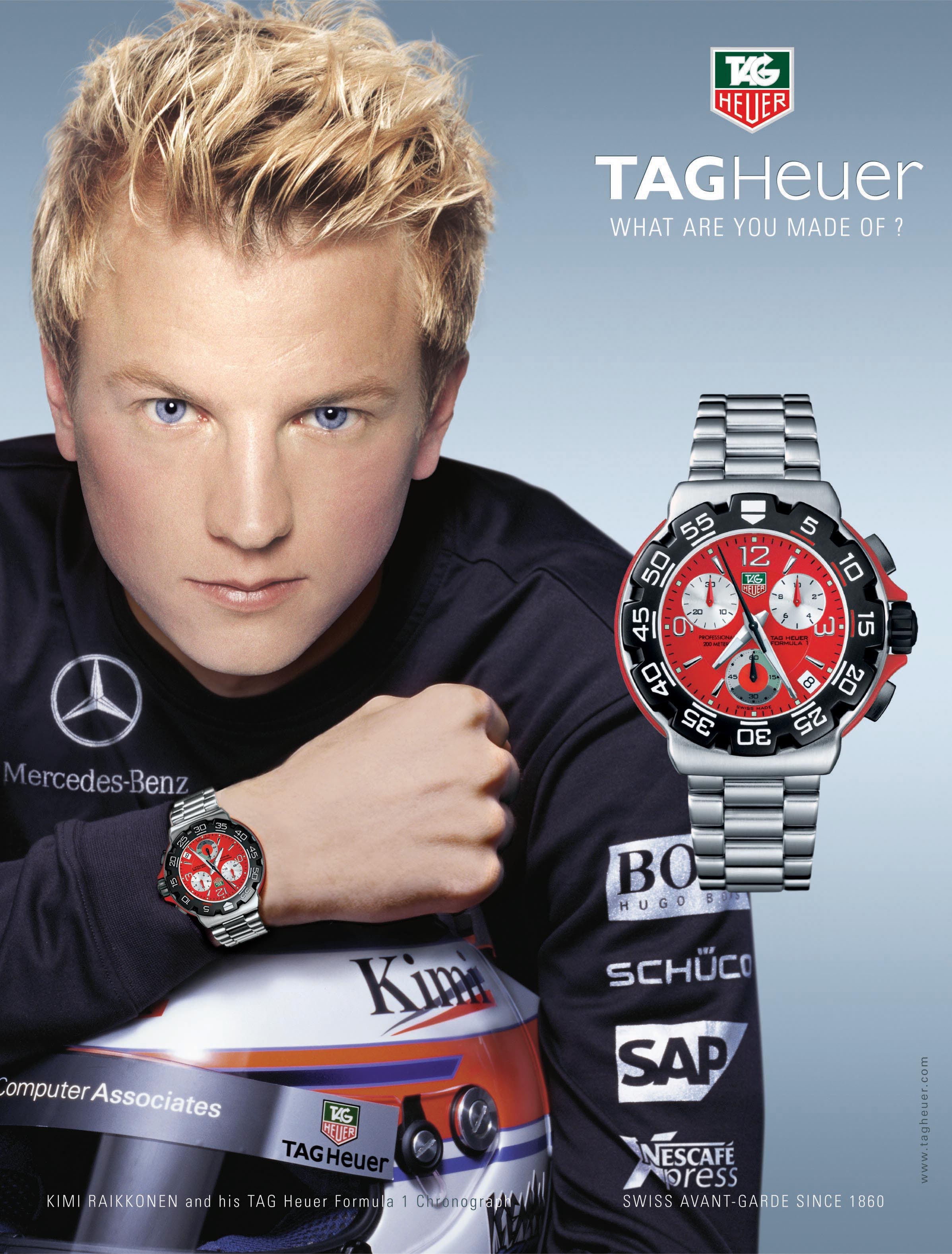
2008: SERIES 4 EXTENSIONS
In 2008, several extensions of the series 4 Formula 1 collection were introduced to keep the watches current and in fashion.
GRANDE DATE - 2008
The Grande Date series (so-called because of the two-digit date window at 12 o’clock) was launched in 2008 with an over-sized 44 mm case. The registers at 9 o’clock and 6 o’clock evoked the instruments of a racecar, while the tachymeter scale on the dial incorporated what had been the symbol of a racing watch for many decades. The Grande Date Chronograph uses the Ronda 5040B movement.
The following year, TAG Heuer launched a three-hand version of the Grande Date Formula 1 watch, using the same 44 mm case. This model brings back printed numerals to the dial and for the first time and used a contrasting register at 6 o’clock to show running seconds. The Grande Date Formula 1 watch used a Ronda 6004B quartz movement.
REVISED FORMULA 1 WATCH - 2010
In 2010 TAG Heuer released a second version of the Formula 1 watch. Key elements of the updateddesign included oversized Arabic numerals for the hours 3-6-9-12, along with luminous dots for the remaining hours. The new watches came in a variety of color choices, including khaki and orange.

In 2012, TAG Heuer launched a revamped Formula 1 collection. While the case shape remained the same, the range settled on a 42 mm case for both watch and chronograph models and the more elaborate designs were dropped. In their place were polished edges, improved quality and a more mature feel. For the first time, the series 5 Formula 1 also introduced a series of automatic movements, using the Calibre 16. While still based in the traditional Formula 1 case, the use of mechanical movements took the Formula 1 series into a different sector of the market.
FORMULA 1 SERIES 6: 2015 - PRESENT
The 2015 Formula 1 models represented perhaps the most significant changes in the collection’s almost 30 year history. In place of the case design that had been used and evolved since the introduction of the Formula 1 collection in 1986, TAG Heuer incorporated an entirely new style of case. This new case for the Formula 1 incorporated the style of the Autavia chronograph from the 1970s, a fitting tribute to the brand’s close connection to racing over the decades.
While the Formula 1 continued to use quartz movements in the collection, TAG Heuer expanded the number of mechanical movements to include Calibre 5, 6 and 7 variants.

The C-shape Formula 1 case derived from the 1970s Autavia chronograph continues into 2020, with perhaps the most significant development of the modern Formula 1 collection being a limited edition collaboration between TAG Heuer and Fragment, the legendary Japanese streetwear brand developed by Hiroshi Fujiwara. The Formula 1 Fragment Limited Edition was a premium model, not only featuring the Heuer 02 in-house movement for the first time in the collection, but also with a design that harks back to the 1970s Autavia more than it does to the 1986 Formula 1. Consistent with the minimalist approach favored by Fujiwara, the dial used red dots to mark the hours, with hash marks at the edge of the dial for minutes / seconds and ¼ second increments.

With Formula 1 watches and chronographs usually occupying the position as the least expensive watches in the TAG Heuer catalogue, the Formula 1 collection was the favorite choice for many limited and special watches. For example, we see early three-hand Formula 1 watches with the “Wings and Wheel” logo of the Indianapolis Motor Speedway on the dial. Contrast these small, light fiberglass models with the limited edition chronograph that TAG Heuer produced for the 2022 Indianapolis 500, which featured 1/10 second accuracy and had the racetrack’s legendary pagoda displayed across the bottom of the dial. TAG Heuer had a special relationship with the legendary Formula 1 champion, Aryton Senna, as Senna wore various TAG Heuer watches and chronographs over the course of his career. In 2022, TAG Heuer paid tribute to Senna with a Special Edition of the Formula 1 chronograph, which featured his name and logo on both the dial and the bezel, along with red accents on the dial, bezel, crown and top pusher. This Limited Edition was powered by TAG Heuer’s Calibre 16 automatic movement, with chronograph registers at the 6-9-12 positions on the dial, and the solid caseback was decorated with an image of Senna’s racing helmet.



